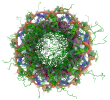Fit of model(s) to SAS data
Cormap p-value analysis of fits ?
ATSAS DATCMP was used for hypothesis testing. All data sets are similar (i.e. the fit and the data collected) is the null hypothesis. p-value is a measure of evidence against the null hypothesis, smaller the value, the stronger the evidence that you should reject the null hypothesis.
| SASDB ID | Model | χ² | p-value |
|---|---|---|---|
|
SASDBV9
|
1
|
1.28
|
0.02
|
|
SASDBV9
|
2
|
1.10
|
0.01
|
|
SASDBW9
|
1
|
1.97
|
0.00
|
|
SASDBZ9
|
1
|
1.94
|
0.00
|
|
SASDBX9
|
1
|
2.86
|
0.00
|
|
SASDBY9
|
1
|
2.02
|
0.00
|
The experimental scattering curve (in blue) can be compared with the theoretical curve calculated from a model (in red). Residual value plot is a measure to assess fit to the data. Residual values should be equally and randomly spaced around the horizontal axis.
Fit of model(s) to crosslinking-MS data
Restraint types
Restraint types are summarized in the table below. Restraints assigned "by-residue" are interpreted as between CA atoms. Restraints between coarse-grained beads are indicated as "coarse-grained". Restraint group represents a set of crosslinking restraints applied collectively in the modeling.
There are 1071 crosslinking restraints combined in 615 restraint groups.
| Linker | Residue 1 | Atom 1 | Residue 2 | Atom 2 | Restraint type | Distance, Å | Count |
|---|---|---|---|---|---|---|---|
| DSS | LYS | coarse-grained | LYS | coarse-grained | upper bound | 26.0 | 916 |
| DSS | LYS | CA | LYS | CA | upper bound | 26.0 | 102 |
| DSS | LYS | coarse-grained | THR | coarse-grained | upper bound | 26.0 | 13 |
| DSS | LYS | coarse-grained | MET | coarse-grained | upper bound | 26.0 | 27 |
| DSS | ASN | coarse-grained | LYS | coarse-grained | upper bound | 26.0 | 2 |
| DSS | ARG | coarse-grained | LYS | coarse-grained | upper bound | 26.0 | 2 |
| DSS | GLN | coarse-grained | LYS | coarse-grained | upper bound | 26.0 | 2 |
| DSS | ALA | coarse-grained | LYS | coarse-grained | upper bound | 26.0 | 2 |
| DSS | LYS | coarse-grained | VAL | coarse-grained | upper bound | 26.0 | 3 |
| DSS | GLN | coarse-grained | MET | coarse-grained | upper bound | 26.0 | 1 |
| DSS | LYS | CA | MET | CA | upper bound | 26.0 | 1 |
Distograms of individual restraints
Restraints with identical thresholds are grouped into one plot. Only the best distance per restraint per model group/ensemble is plotted. Inter- and intramolecular (including self-links) restraints are also grouped into one plot. Distance for a restraint between coarse-grained beads is calculated as a minimal distance between shells; if beads intersect, the distance will be reported as 0.0. A bead with the highest available resolution for a given residue is used for the assessment.
Satisfaction of restraints
Satisfaction of restraints is calculated on a restraint group (a set of crosslinking restraints applied collectively in the modeling) level. Satisfaction of a restraint group depends on satisfaction of individual restraints in the group and the conditionality (all/any). A restraint group is considered satisfied, if the condition was met in at least one model of the model group/ensemble. The number of measured restraints can be smaller than the total number of restraint groups if crosslinks involve non-modeled residues. Only deposited models are used for validation right now.
| State group | State | Model group | # of Deposited models/Total | Restraint group type | Satisfied (%) | Violated (%) | Count (Total=615) |
|---|---|---|---|---|---|---|---|
| 1 | 1 | 1 | 1/5 | All | 87.52 | 12.48 | 609 |
| Self-links/ Intramolecular |
96.67 | 3.33 | 300 | ||||
| Heteromeric links/ Intermolecular |
75.37 | 24.63 | 268 | ||||
| Self-links/ Ambiguous |
100.00 | 0.00 | 37 | ||||
| Self-links/ Intermolecular |
100.00 | 0.00 | 4 |
Per-model satisfaction rates in model groups/ensembles
Every point represents one model in a model group/ensemble. Where possible, boxplots with quartile marks are also plotted.
